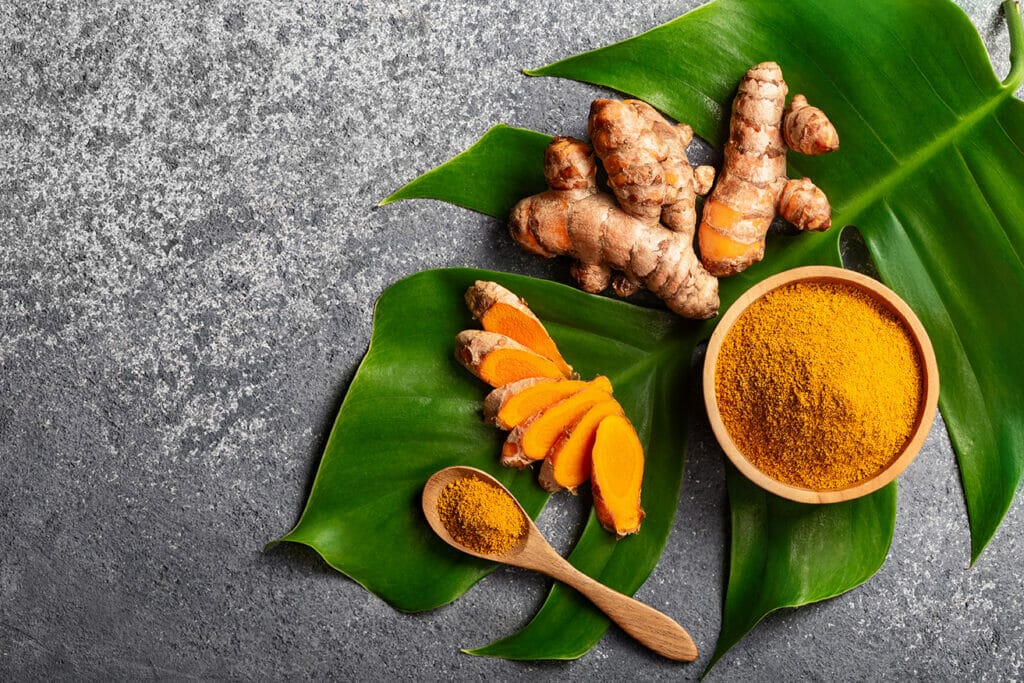Turmeric – striking a golden balance and navigating troublesome menstrual cycles
From its sacred roots to a modern-day triumph, turmeric has rightly placed itself on the global stage not just for its rich and vibrant golden hue that is used in many dishes, but also for its medicinal properties is reflected in the global market where turmeric is forecast to be valued at US$7,579 million by 2033.[i]
Turmeric is a spice that comes from the root of the plant called curcuma longa which is related to the ginger family. Native to southeast Asia it thrives in warm and humid climates and is also known as ‘Indian saffron’ due to its bright yellow colour. It has been not only used for its culinary delights, dying textiles, skin care and religious ceremonies but also for its medicinal purposes.
This golden spice has been used therapeutically for thousands of years in the Indian system of holistic medicine called Ayurveda and now modern medicine has recognised its potential to positively impact human health through scientific research and clinical studies over the last 25 years.[ii]

Turmeric and curcumin
Of the many compounds found naturally within the turmeric plant, curcumin which belongs to the curcuminoid group has had a great deal of attention in recent years. They not only give the plant its distinctive colour but have been hailed for their multiple supportive health benefits which include[iii] –
- Anti-inflammatory effects
- Antioxidant defence
- Modulation of Immune response
- Brain health.
- Heart health
- Metabolic syndrome
- Antimicrobial[iv]
- Antiviral
- Antifungal
- Skin health and much more

Menstrual pain relief?
In Ayurvedic medicine, turmeric was and is used to treat a wide range of conditions such as ulcers, coughs, skin complaints, biliary disorders, sprains, swellings, rheumatic disorders, and inflammation.[v]In ancient times, women embraced the abundant benefits of using it in their skincare to enhance their radiance, as well as to help bring menstrual harmony due to its anti-inflammatory properties that can help to ease pain and discomfort associated with their monthly menstrual cycle.
Heavy, painful periods (dysmenorrhea) is a very common menstrual complaint that can have a major impact on a woman’s quality of life, work productivity and social interactions. In studies, the prevalence varied between 16% and 91% of women in reproductive age with severe pain in 2%-29% of the women studied.[vi]
There can be numerous contributing factors and triggers that can determine a woman’s hormonal journey such as stress, family history, sleep insufficiency, unhealthy food and lifestyle habits, toxicity and mineral imbalances. Hormonal imbalances caused by oestrogen dominance, also known as unopposed oestrogen, often act as a common trigger for painful periods. This imbalance is intricately linked to a range of female concerns, including PMT, tender breasts, fibroids, mood swings and more.
Elevated oestrogen levels can prompt an excessive release of uterine prostaglandins, hormone-like chemicals that orchestrate various physiological processes. Within the uterus, these localised prostaglandins are responsible for inducing blood vessel contractions and smooth muscle contractions, which in turn lead to the painful cramps experienced during menstruation.
Interestingly, the hormone progesterone assumes a role akin to a peacekeeper within this hormonal orchestra. Progesterone’s presence brings anti-inflammatory effects, regulating the excess production of these prostaglandins while simultaneously fostering a balance within oestrogen levels.
Natural solutions
Diet and lifestyle modifications and exploring detoxification and elimination strategies are often needed as toxicity plays a major role in female hormonal balance and health. Many women are seeking more natural solutions to alleviate their discomfort, moving beyond a hot water bottle, painkillers, and days of misery. Yoga, massage, meditation, acupuncture have all been shown to be helpful. Other supportive measures for cramps and discomfort could include Magnesium, Omega 3-fatty acids, Evening primrose oil and C*B*D oil.
In studies, the active curcuminoids in turmeric have shown to help alleviate menstrual cramps by virtue of their ability to inhibit high prostaglandin levels.[vii] Curcumin has poor solubility as it does not dissolve easily in water, therefore has lower absorbability, so most of what is ingested will be excreted through the bowel. It is, however, fat-soluble, so we need to eat a little fat to support and aid its absorption or add black pepper which contains a compound called piperine, that can also substantially improve its absorption. Incorporating turmeric into our diet is very simple, we can make warming turmeric milks, add to smoothies, foods, and other drinks.

Turmeric supplements
When it comes to supplementing with turmeric one way to ensure excellent bioavailability of the curcuminoids is through a technology called the UltraSol Delivery system that converts fat loving compounds (lipophilic), into water-soluble molecules where it increases its absorption and availability.
Turmeric, the revered ancient spice cherished by women across generations has not only graced women with its touch of outer radiance but can also bring support during the monthly hormonal challenges that women navigate.
[i] https://www.futuremarketinsights.com/reports/turmeric-market
[ii] https://www.ncbi.nlm.nih.gov/books/NBK92752/
[iii] Hewlings SJ, Kalman DS. Curcumin: A Review of Its Effects on Human Health. Foods. 2017 Oct 22;6(10):92. doi: 10.3390/foods6100092. PMID: 29065496; PMCID: PMC5664031.
[iv] Adamczak A, Ożarowski M, Karpiński TM. Curcumin, a Natural Antimicrobial Agent with Strain-Specific Activity. Pharmaceuticals (Basel). 2020 Jul 16;13(7):153. doi: 10.3390/ph13070153. PMID: 32708619; PMCID: PMC7408453.
[v] Toden S, Goel A. The Holy Grail of Curcumin and its Efficacy in Various Diseases: Is Bioavailability Truly a Big Concern? J Restor Med. 2017 Dec;6(1):27-36. doi: 10.14200/jrm.2017.6.0101. PMID: 30899605; PMCID: PMC6424351.
[vi] Ju H, Jones M, Mishra G. The prevalence and risk factors of dysmenorrhea. Epidemiol Rev. 2014;36:104-13. doi: 10.1093/epirev/mxt009. Epub 2013 Nov 26. PMID: 24284871.
[vii] https://www.sciencedirect.com/science/article/abs/pii/S0928098721000452







